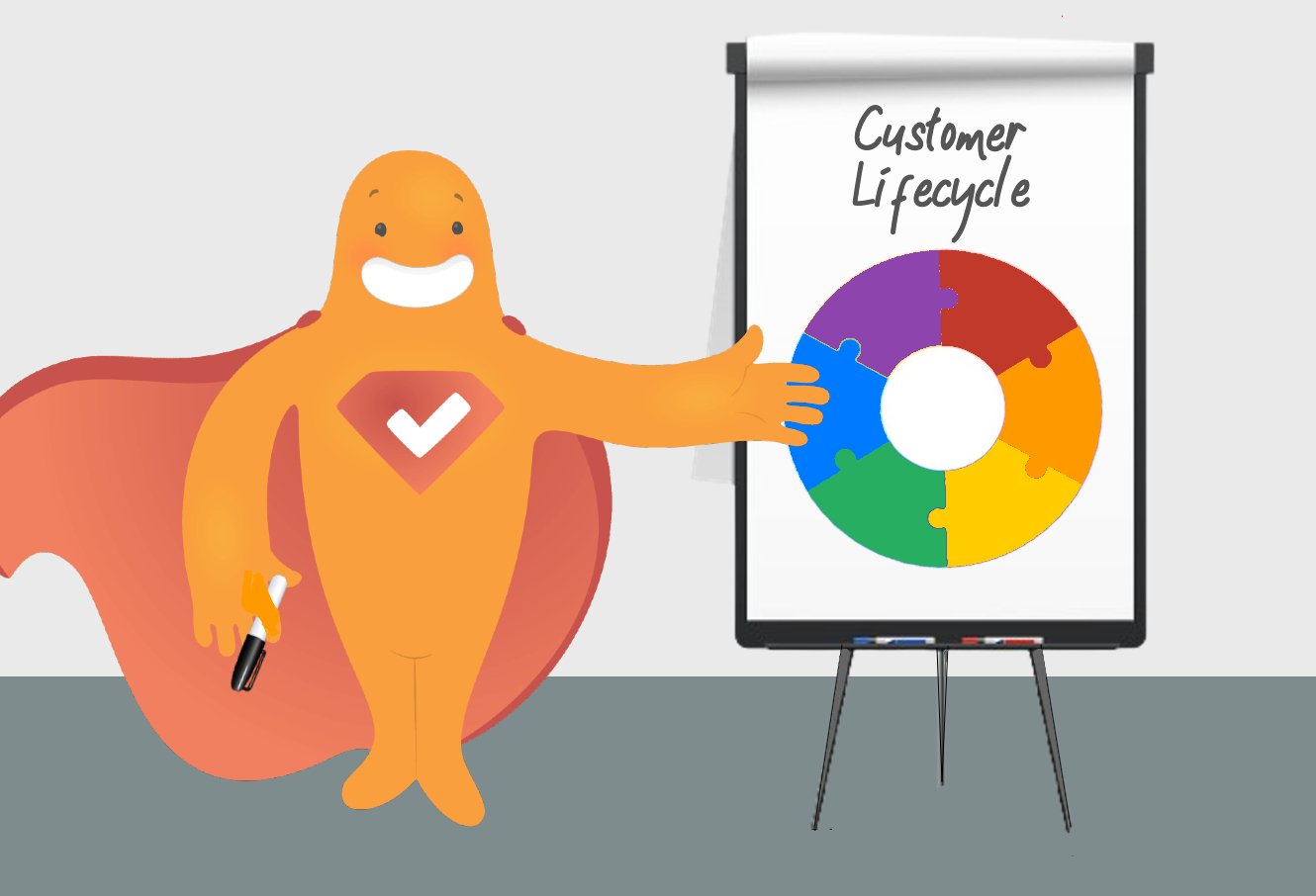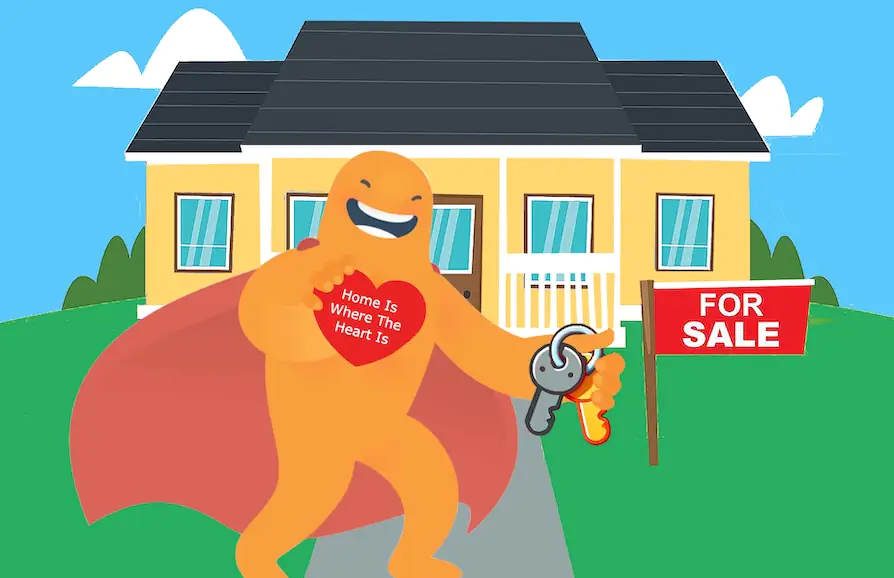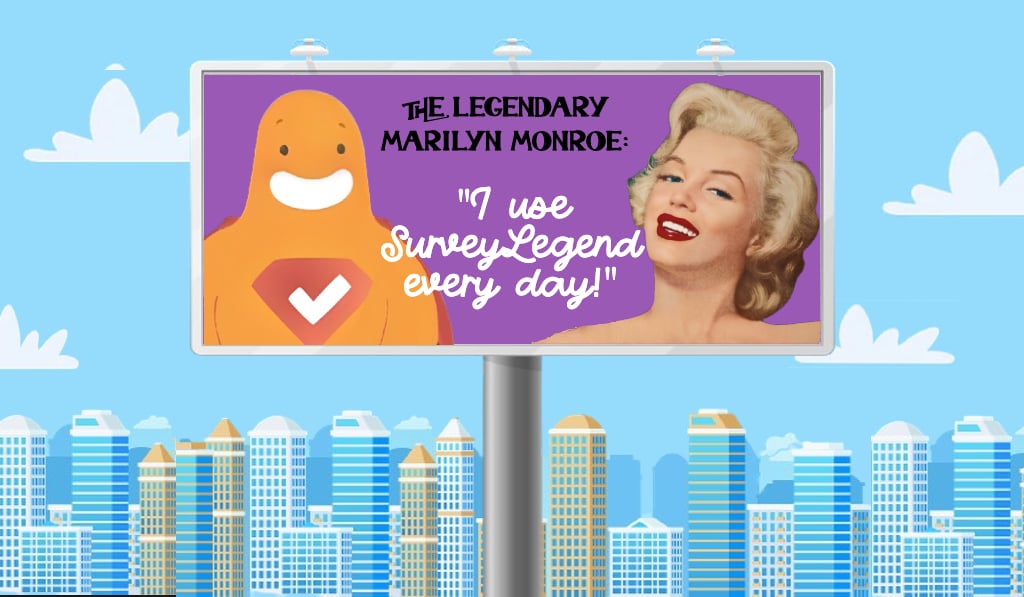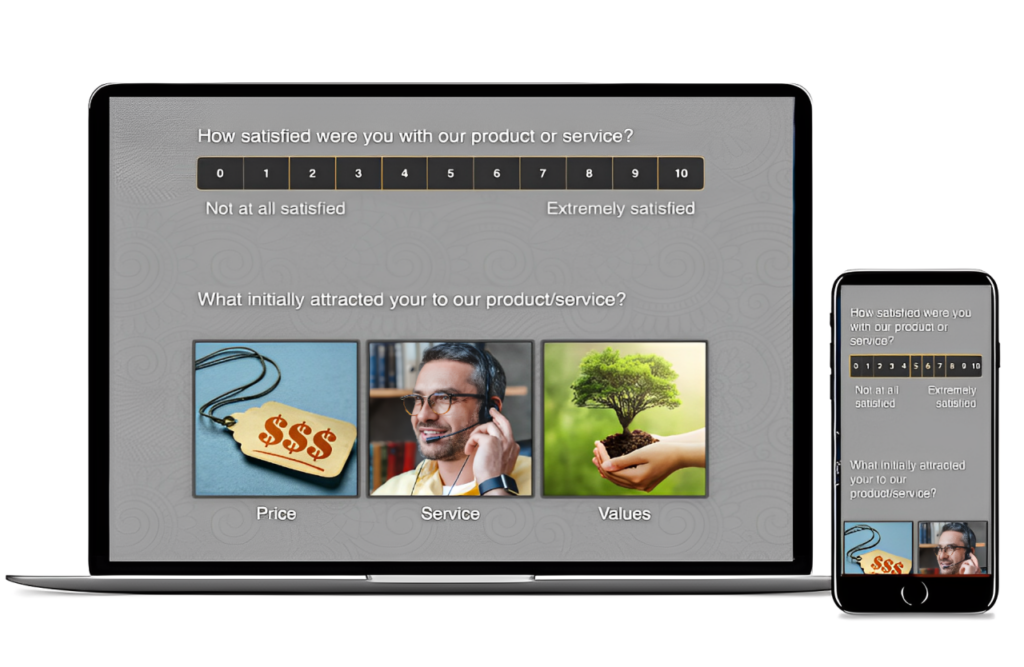There is a famous quote that says, “Life is a journey, not a destination.” The same could be said for the customer lifecycle. As it is known in marketing, the customer or consumer lifecycle is the journey a person goes through from the initial awareness of a product or service to the final stage of brand advocacy or exit (at this point, the cycle could even begin again).
To better understand the customer lifecycle, and to make it an ongoing journey, marketers typically survey consumers throughout the process, which we’ll take a look at in this blog. We’ll also dive into the importance of the customer lifecycle, brands that excel at marketing throughout the journey, benefits and objectives of lifecycle marketing, and best practices to keep in mind.
Create Your FREE Customer Lifecycle Survey Now!
Six Steps in the Customer Lifecycle
Some companies follow the four-step cycle, others the five-step cycle. To be comprehensive, SurveyLegend looks at the six-step customer lifecycle, which goes as follows:
- Prospecting stage, where potential customers become aware of and develop an interest in a product.
- Onboarding stage, where new customers make their first purchase and start using the product, requiring guidance and support.
- Engagement stage, where customers regularly use the product, and their satisfaction and engagement levels are crucial.
- Retention stage, where businesses focus on maintaining customer loyalty and preventing churn through ongoing value delivery and satisfaction.
- Advocacy stage, where satisfied customers become brand advocates, promoting the product through positive word-of-mouth.
- Renewal or exit stage, where businesses collect feedback from customers who are approaching the end of their subscription or contract period and are considering renewing their commitment or opting out for good.
Understanding the consumer lifecycle helps businesses tailor their marketing, support, and development efforts to meet customers’ needs at each stage, fostering long-term relationships and driving growth.
Why Is The Consumer Lifecycle Important For Marketing?
The consumer lifecycle provides a framework for understanding and engaging with customers at every stage of their journey. By recognizing the distinct phases highlighted previously, marketers can develop targeted strategies that address specific customer needs and behaviors, leading to more effective and relevant marketing efforts. This tailored approach improves satisfaction and enhances the customer experience. Why is this important? According to PwC, 86% of buyers are willing to pay more for a great customer experience!
Monitoring the customer lifecycle also helps marketers identify potential churn risks early, so they can take proactive steps to retain customers (The Harvard Business Review reports that increasing customer retention rates by just 5% can increase profits by 25% to 95%). Of course, keeping customers leads to more repeat purchases, upsells, and cross-sells, making each customer more profitable over time (this is known as the customer lifetime value, or CLV). Additionally, by cultivating positive relationships, businesses can turn satisfied customers into brand advocates, who provide valuable word-of-mouth promotion and authentic testimonials.
Three Companies That Excel At Managing the Customer Lifecycle
Several companies demonstrate a strong understanding of customer needs and the importance of delivering exceptional experiences at each stage. Here are a few examples:
1. Amazon
This company has evolved from an online book seller to the second largest retailer in the world (just behind Walmart). Its growth has stemmed from its customer-centric approach, which includes personalized product recommendations during the prospecting stage, seamless onboarding experiences, efficient delivery processes, and proactive customer service for engagement and retention, and loyalty programs like Amazon Prime to foster advocacy and renewal.
2. Apple
From innovative product design and intuitive onboarding processes to ongoing software updates, customer support, and community engagement, Apple cultivates a loyal customer base that eagerly anticipates new releases and upgrades, often waiting for hours outside of stores to be the first to purchase a new release; in fact, one man holds the record (240 hours) for camping outside an Apple store to be the first to get his hands on an iPhone 4S!
3. Disney
There’s a reason Disney celebrated its 100th year in business in 2023! The “mouse house” is renowned for its ability to create magical experiences that captivate customers from the moment they become aware of its brands. Whether it’s through movies and music, captivating characters, immersive theme park experiences, high-quality products and services, or personalized interactions across various touchpoints, Disney maintains strong emotional connections with its customers throughout their lifecycle.
Create Your FREE Customer Lifecycle Survey Now!
The Six Stages of the Customer Lifecycle
Now, let’s take a closer look at the six stages of the customer lifecycle, including objectives, methods, examples, and benefits.
1. Prospecting Stage
Surveying in the prospecting stage involves collecting feedback from potential customers who have not yet made a purchase but are aware of and interested in your product or service.
Objectives
- Identify Customer Needs: Understand the specific problems or needs that prospects are looking to address with your product or service.
- Gauge Interest Levels: Measure the level of interest and intent among potential customers.
- Understand Awareness Sources: Determine how prospects discovered your brand (advertising, social media, friends or family, etc).
- Identify Barriers to Purchase: Learn about any concerns or obstacles that might prevent prospects from making a purchase.
- Refine Marketing Messages: Use feedback to adjust and improve your marketing messages to better resonate with your target audience.
Methods
- Website Exit Surveys: Pop-up surveys that appear when visitors are about to leave your website, asking about their experience and why they didn’t make a purchase. Read our blog on popup surveys.
- Social Media Polls: Quick polls on platforms like Instagram, Facebook, or X to gather insights from your social media followers. Read our blog on social media surveys.
- Pre-Sale Email Surveys: Short surveys sent to individuals who have signed up for newsletters or expressed interest in your product but haven’t purchased yet.
- Landing Page Surveys: Surveys embedded on landing pages to capture immediate feedback from visitors about their interest and what they’re looking for.
Benefits
- Improved Product-Market Fit: By understanding prospect needs and preferences, businesses can better align their products and services with market demands.
- Enhanced Marketing Strategies: Insights from surveys help refine marketing campaigns to more effectively target and convert prospects.
- Increased Conversion Rates: Addressing the barriers and concerns identified through surveys can reduce friction in the purchase process and boost conversion rates.
- Better Customer Insights: Early feedback provides valuable insights into the expectations and motivations of potential customers, guiding strategic decisions.
Example Survey Questions
- What problem are you trying to solve?
- How did you hear about us?
- What features are you looking for in a product/service like ours?
- What concerns or questions do you have about our product/service?
- What would make you more likely to purchase from us?
2. Onboarding Stage
Surveying in the onboarding stage involves collecting feedback from new customers who have recently made their first purchase or started using your product or service.
Objectives
- Assess Initial Satisfaction: Measure how satisfied new customers are with their early experiences.
- Identify Onboarding Challenges: Discover any difficulties or obstacles customers encounter during the setup or initial use.
- Understand Expectations: Verify if the product or service meets the expectations set during the sales process.
- Guide Improvement Efforts: Gather insights to refine and improve the onboarding process.
- Encourage Engagement: Promote further engagement and usage of the product or service.
Methods
- Welcome Surveys: Sent shortly after a customer makes their first purchase or begins using the product, often via email or within the app. Be sure to start with a welcome page!
- Follow-up Emails: Timed emails that check in with new customers after they’ve had some time to use the product.
- In-App Surveys: Short surveys integrated into the product experience, prompting users to provide feedback during their initial interactions.
- Customer Onboarding Calls: Although telephone surveys are becoming more rare these days, a personalized call to new customers to discuss their onboarding experience and gather feedback can be beneficial.
Benefits
- Improved Customer Experience: Early feedback helps identify and fix issues, ensuring a smoother experience for new customers.
- Increased Customer Retention: Addressing onboarding challenges promptly can reduce early churn and increase the likelihood of customers staying with your product or service.
- Higher Engagement Rates: Understanding how new customers interact with the product allows for targeted efforts to encourage deeper engagement.
- Enhanced Product Development: Feedback from onboarding surveys can inform product development and feature enhancements that better meet customer needs.
- Strengthened Customer Relationships: Demonstrating a commitment to listening and improving based on feedback builds trust and fosters positive customer relationships.
Example Survey Questions
- How would you rate your experience with our sign-up process?
- Was the product/service easy to understand and start using?
- Did you encounter any problems or challenges during the onboarding process?
- Is there any additional help or information you need?
- How likely are you to continue using our product/service?
- What can we do to improve your onboarding experience?
3. Engagement Stage
In the engagement stage, customer engagement surveys focus on a customers’ continued usage of the product/service to see how it is performing over time. While this stage still includes aspects of the onboarding stage, the main goal is to begin fostering long-term loyalty.
Objectives
- Foster Customer Loyalty: Use a customer loyalty survey to identify opportunities to enhance customer loyalty and retention.
- Assess Customer Satisfaction: Measure how satisfied customers are with the product or service.
- Understand Usage Patterns: Learn how customers are using the product and identify any challenges they face.
- Gather Feedback for Improvement: Collect insights on how the product or service can be improved.
- Measure Engagement Levels: Determine the frequency and depth of customer interactions with the brand.
Methods
- Online Surveys: Distribute surveys via email, social media, or within the product interface.
- In-App Feedback: Use pop-up surveys or feedback forms within mobile or web applications.
- Customer Interviews: Conduct one-on-one interviews for in-depth insights.
- Focus Groups: Organize group discussions with customers to gather qualitative feedback.
- Social Media Monitoring: Analyze customer interactions and feedback on social media platforms.
- Analytics Tools: Use tools to track user behavior and engagement metrics.
Benefits
- Increased Customer Loyalty: Engaged customers are more likely to become repeat buyers and advocates for the brand.
- Improved Customer Experience: By understanding customer needs and challenges, businesses can enhance their products and services.
- Higher Retention Rates: Identifying and addressing issues early can prevent customer churn.
- Product Development Insights: Direct feedback can guide product enhancements and new feature development.
- Competitive Advantage: Engaging with customers effectively can differentiate a brand from its competitors.
- Data-Driven Decisions: Insights from engagement surveys support more informed business decisions.
Example Survey Questions
- What do you like most about our product/service?
- What improvements would you suggest for our product/service?
- How frequently do you use our product/service?
- Which features do you use the most?
- How likely are you to recommend our product/service to others? (Net Promoter Score)
- What factors influence your decision to continue using our product/service?
- What additional features or services would you like us to offer?
- How can we make your experience better?
4. Retention Stage
The customer retention survey stage involves collecting feedback from existing customers who have been using your product or service for some time. The goal at this stage is mainly to detect potential churn risks in order to take proactive steps to retain customers who may be considering leaving or using a competing product.
Objectives
- Detecting Potential Churn Risks: Identify early warning signs of dissatisfaction that could lead to customers leaving.
- Competitive Analysis: Determine whether customers may switch to a competitor and why (product, price, availability, etc).
- Measure Customer Satisfaction: Assess how happy customers are with your product or service over time.
- Identify Loyalty Drivers: Understand what aspects of your product or service keep customers coming back.
- Enhance Customer Engagement: Gather insights on how to improve and maintain customer engagement.
Methods
- Periodic Satisfaction Surveys: Regularly scheduled surveys (e.g., quarterly or annually) to gauge ongoing satisfaction.
- Net Promoter Score (NPS) Surveys: Surveys that measure the likelihood of customers recommending your product or service to others. SurveyLegend has 10 blogs on NPS, be sure to check them out!
- In-App Feedback: Collecting feedback within the application or service interface, often triggered by specific actions or time intervals.
- Customer Health Score Surveys: Using a combination of quantitative and qualitative data to assess overall customer health and engagement,
Benefits
- Reduced Churn Rates: Early identification of dissatisfaction allows for proactive measures to prevent customers from leaving.
- Understanding Competition: Identifying areas the competition is doing better than you can lead to improvements in product, changes in price, utilization of different promotions, and so on.
- Improved Customer Satisfaction: By addressing ongoing needs and concerns, businesses can keep customers happy and satisfied.
- Increased Customer Loyalty: Understanding what drives loyalty helps reinforce those aspects to build stronger customer relationships.
- Enhanced Product Development: Continuous feedback informs product enhancements and innovation, ensuring the product evolves with customer needs.
Example Survey Questions
- How satisfied are you with our product/service overall?
- What features do you use the most, and why?
- Are there any features you feel are missing or could be improved?
- Have you encountered any issues or challenges recently?
- Have you considered using one of our competitor’s products or services?
- What about our competition do you find appealing?
- How likely are you to recommend our product/service to a friend or colleague? (NPS)
5. Advocacy Stage
Surveying in the advocacy stage involves collecting feedback from customers who are highly satisfied with your product or service and are likely to recommend it to others. Advocacy surveys help businesses cultivate strong relationships with their most loyal customers and harness their enthusiasm to support marketing and growth efforts.
Objectives
- Understand Drivers of Loyalty: Identify the specific factors that make customers enthusiastic about your product or service.
- Gauge Willingness to Recommend: Measure how likely customers are to refer your product or service to others.
- Collect Testimonials and Reviews: Gather positive feedback that can be used in marketing materials and on your website.
- Identify Opportunities for Improvement: Even loyal customers may have suggestions for enhancing the product or service.
- Strengthen Customer Relationships: Engage with advocates to deepen their connection to your brand.
Methods
- Net Promoter Score (NPS) Surveys: These surveys ask customers how likely they are to recommend your product or service to others on a scale from 0 to 10. Be sure to check out our example blog on surveying through the car buyer’s journey.
- Post-Purchase Surveys: Surveys sent after a significant purchase or renewal to gather feedback on the entire experience.
- Customer Feedback Forms: Detailed forms that allow advocates to provide in-depth feedback and suggestions.
- Testimonial Requests: Direct requests for testimonials or reviews that can be featured in marketing campaigns.
Benefits
- Enhanced Marketing Efforts: Positive feedback/testimonials from advocates can be used in marketing materials.
- Improved Customer Loyalty: Engaging with advocates reinforces their loyalty and shows that their opinions are valued.
- Product and Service Enhancements: Even advocates can provide valuable suggestions for improvements, helping you refine offerings.
- Increased Referrals: Understanding what drives advocacy can help you create programs and incentives that encourage more referrals.
- Data-Driven Insights: Feedback from your most loyal customers provides deep insights into what makes your product or service exceptional.
Example Survey Questions
- How likely are you to recommend our product/service to a friend or colleague? (NPS)
- What do you like most about our product/service?
- Can you describe a specific instance where our product/service exceeded your expectations?
- What improvements would you like to see in our product/service?
- Would you be willing to provide a testimonial or review?
- How can we make your experience even better?
6. Renewal or Exit Stage
Surveying at the renewal stage involves collecting feedback from customers who are approaching the end of their subscription or contract period and are considering renewing their commitment to your product or service.
Objectives
- Assess Renewal Intentions: Determine the likelihood of customers renewing their subscription or contract.
- Identify Reasons for Renewal: Understand what factors contribute to customers’ decision to renew their commitment.
- Detect Churn Risks: Identify any dissatisfaction or issues that may lead customers to consider not renewing.
- Improve Renewal Process: Gather feedback to streamline the renewal process and make it more efficient and user-friendly.
- Strengthen Customer Relationships: Engage with customers to demonstrate your commitment to their satisfaction and to address any concerns they may have.
Methods
- Renewal Intent Surveys: Surveys sent nearing the end of customer subscription/contract periods to gauge the likelihood of renewal.
- Exit Surveys for Non-Renewing Customers: Surveys sent to customers who choose not to renew to understand their reasons for churn.
- Customer Interviews: In-depth interviews with select customers to explore renewal decision-making and gather detailed feedback.
- Renewal Feedback Forms: Online forms embedded in renewal communication to collect feedback on the renewal experience,
Benefits
- Increased Renewal Rates: By understanding customers’ renewal intentions and addressing their concerns, businesses can increase the likelihood of customers renewing their subscription or contract.
- Reduced Churn: Early detection of churn risks allows businesses to take proactive measures to retain customers.
- Enhanced Customer Satisfaction: Gathering feedback on the renewal process helps identify areas for improvement, leading to a smoother and more satisfying experience for customers.
- Better Understanding of the Competition: Learn why customers prefer your competitors so you can adjust product, pricing, promotion, and so on before others leave; doing so could also woo back those you have lost.
- Customer Retention and Loyalty: Engaging with customers during the renewal process demonstrates a commitment to their satisfaction and strengthens the relationship, leading to long-term loyalty.
Example Survey Questions
- How likely are you to renew your subscription/contract with us?
- What factors are influencing your decision to renew/not renew?
- What do you value most about our product/service?
- Have you encountered any issues or challenges that have impacted your decision to renew?
- How can we improve the renewal process to better meet your needs?
- Are you leaving us to switch to a competitive product? If so, please tell us how they better meet your needs.
Create Your FREE Customer Lifecycle Survey Now!
10 Best Practices for Customer Lifecycle Surveys
- Keep Timing In Mind: Send surveys shortly after the customer has had a chance to experience the product but not so late that the initial impressions fade.
- Keep Surveys Short: Respect the customer’s time by keeping surveys concise and focused on the most critical aspects of their onboarding experience. If possible, consider a time-efficient microsurvey.
- Personalize When Possible: Tailor questions to the specific product or service and the customer’s interactions.
- Close the Loop: Communicate back to customers about how their feedback has been used to make positive changes. If you do not, they may feel their time was wasted and will be reluctant to participate in future surveys. Read our blog on Closed Loop Surveys.
- Survey At Regular Intervals: Conduct surveys at regular intervals to track changes in customer satisfaction and engagement over time. This is very helpful for benchmarking.
- Segment Your Surveys: Tailor surveys to different customer segments to gather more relevant and specific feedback. You can use demographic information to make this process easy.
- Write Good Survey Questions: Craft your questions carefully to avoid survey bias, ambiguity, leading and loaded questions, etc. Our free guide How to Write Survey Questions Like An Expert will help.
- Act Promptly to Negative Feedback: Respond quickly to unhappy customers to show you are committed to improvement. This can also avoid social media backlash which may damage to your reputation.
- Consider Incentivizing Participation: If you’re not getting enough feedback, you may need to offer incentives to encourage participation. Read our blog on Survey Incentive Ideas and the Pros & Cons of Survey Incentives.
- Encourage Storytelling: Ask open-ended questions that allow advocates to share their stories and experiences. Their comments can be used in future advertising or promotional efforts if you include a release form.
Conclusion
Surveying through the customer lifecycle is essential for businesses to gain valuable insights into customer needs, satisfaction levels, and loyalty drivers at each stage of their journey. By systematically collecting feedback from prospects, new customers, existing customers, and advocates, businesses can tailor their marketing strategies, improve their products or services, and enhance the overall customer experience leading to sustainable, long-term success.
Ready to start now? SurveyLegend has you covered! With a track record of delivering high-quality survey solutions and generating reliable insights for clients, we are the winner of the G2 High Performer Badge 2024. That’s not all – our platform offers a wide variety of survey question types, high levels of security, page and skip logic, and render beautifully on any device. Start today for free!
Have you surveyed customers on their journey in the past? Has it proven successful in customer retention or developing customer loyalty? We want to hear from you – and hope you’ll give SurveyLegend a try!
Create Your FREE Customer Lifecycle Survey Now!
Frequently Asked Questions (FAQs)
The customer lifecycle refers to the journey that a customer takes from initial awareness of a product or service through the various stages of engagement, purchase, and loyalty. It encompasses the prospecting, onboarding, engagement, retention, and advocacy stages, providing businesses with a framework to understand and address customer needs at each phase of their interaction.
The customer lifecycle has six stages: prospecting, onboarding, engagement, retention, advocacy, and renewal/exit.
Ignoring the customer lifecycle can lead to missed opportunities for understanding and meeting customer needs at different stages of their journey. This oversight may result in decreased customer satisfaction, higher churn rates, and reduced loyalty. Ultimately, neglecting the customer lifecycle can hinder growth, limit profitability, and diminish the long-term success of a business.




